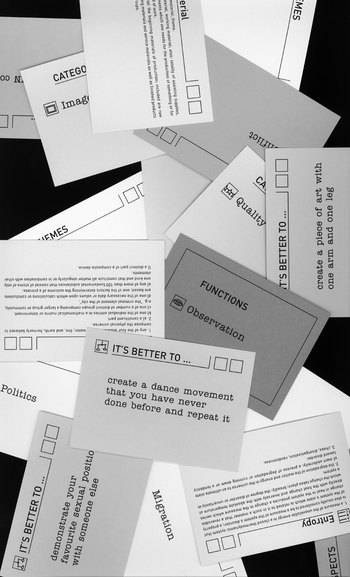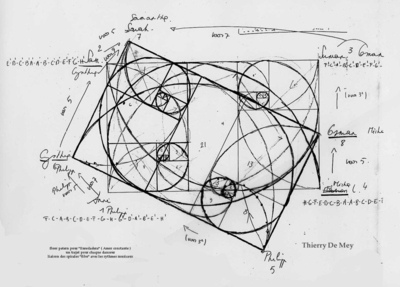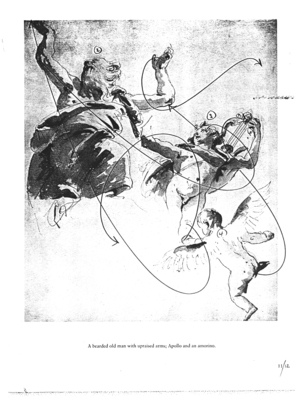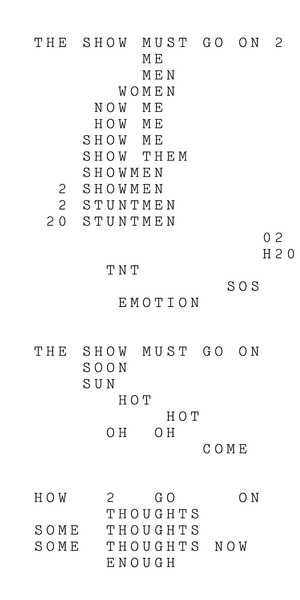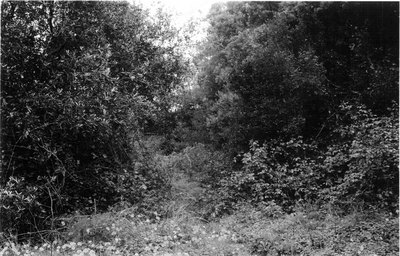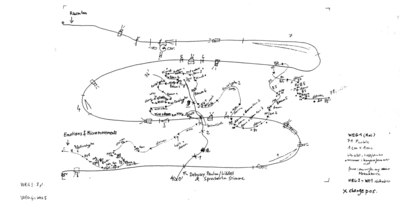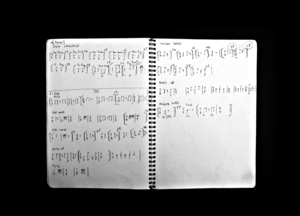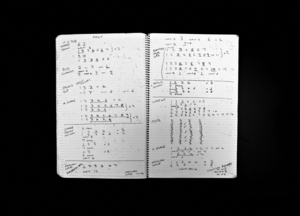ESSAY
Rests in Pieces
On Scores, Notation and the Trace in Dance
by Myriam Van Imschoot
This text was originally written in English and first published in French as an introductory essay to a publication of scores by the artist Ludovic Burel and myself in the French magazine Multitudes (Spring 2005, nr. 21). All scores stemmed from then recent dance and performance practice, selected after a round of conversations with a group of artists. For the occasion of this publication, the text was only slightly revised. I have not updated the text in terms of references to artistic practices, nor to the increasingly extensive literature one can find on the archive. As such, the text became in its own way a document, indexical of a specific time and context, ready to make new alliances. (2010)
Translations available in French and Portuguese.
First part
“Archè, we recall, names at once the commencement and the commandment. This name apparently coordinates two principles in one: the principle according to nature or history, there where things commence — physical, historical, or ontological principle — but also the principle according to the law, there where men and gods command, there where authority, social order are exercised, in this place from which order is given — nomological principle.”
— Jacques Derrida, Archive Fever (p.1)
In her essay Archives. Performance Remains, performance theorist Rebecca Schneider thoroughly questions the archival logic that operates in western culture. According to her, the archive is inscribed in our habits insofar as we understand ourselves in relation to the remains that we accumulate. The archive is “a utopian “operational field of projected total knowledge”” on the basis of which the law derives its authority to “command”1. The archive is not only the guardian of professed “origins”, but also the guard who polices: its practice of conservation is also a matter of patriarchal conservatism. Its protective embrace of storing and housing is simultaneously a normative gesture of restoration with the force of an imperative.
In his 1995 book Archive Fever. A Freudian Impression, Jacques Derrida points at this dual structure, when he refers to the etymological roots of the archive, the “archè”, which can relate both to commencement and commandment. Derridaʼs book has taken an important foothold in performance theory, because of its implications for performance. Seen through the lens of archival logic, performance is that which does not remain and therefore appears as a “loss”. This deeply rooted perception explains the somewhat problematic status performance has within western culture, a reputation it shares with oral culture at large. In that sense, we could complete the string of Derridaʼs dual structure of commencement-commandment with a third value: the condemnation. As Leonardo da Vinci said about music, which he believed inferior to painting, “Infortunée musique”, “qui périt aussitôt créée” (“unfortunate music”, “which is consumed in the very act of its birth”)2. Because visual art takes the form of a tangible object with permanence and durability, it was thought to be more “advanced” than music, and for that matter all art whose medium is unstable (sound, gesture, etc.) and which must rely on “interpretation” (or “performance”, the English term) to exist, was considered to be “une activité toujours à périr et toujours à recommencer” (a constantly vanishing activity that has to be constantly restarted).
It is in the light of this long tradition of condemnation that the performing arts have been looking for salvation. Music could overcome its “misfortune” and obtain respectability in so far as it succeeded to obtain a certain “graspability” in the confines of the musical object: the score. Its refined system of notation, developed over 2000 years and nearly universally applied, could secure a stability in very much the same way as the archive functions: it consecrated an “origin”, the composition, which would then become the “commandment” for all the interpretations to come. From the site of “writing”, the score would regulate and prescribe the action. Even long after the composer had died, he could therefore spectrally haunt the afterlife of his creation by way of the score, a bare-boned skeleton in search of new flesh3. Rebecca Schneider draws attention to this polarity of bones and flesh, when she equates the archive with the bones. The archive is fixated on the bones, which are the leftovers once the flesh has decomposed. It depreciates the soft matter, the malleable stuff where the laws of entropy are more clearly visible. Every archive is therefore also a mausoleum, a tomb that guards the remaining pieces, i.e. the bones and not the flesh.
It was for a long time believed that if dance could take on the model of music and extend itself into a “written object”, it would as well be able to survive its short lifespan and build a more solid foundation for its history. Maybe the performances themselves would still perish, but thanks to the “cryptic” symbols of notation dance pieces could nevertheless be reanimated in a perpetual series of resurrection. From the seventeenth century onwards, quite advanced dance notation systems like those developed by Pierre Beauchamps (1636-1705) and Raoul-Auger Feuillet (1675-1710) and, later in the twentieth century, the one developed by Rudolf von Laban, have circulated widely and had a more or less committed following4.
In retrospect, however, one can now see that none of the systems could establish a lasting or pervasive foothold. When looking for an overview on the notational endeavors of choreographers and dance makers in the last centuries, what one sees is more a sort of “babelisation” of idiosyncratic instructions than a commonly and widely applied overarching language. To some, the dream of making dance visible and thus indelible has therefore proven to be an illusion. Unable to furnish the bones, dance would linger outside, on the threshold of the archive. Its practitioners could not practice the necrophilic archival love of the remainder (the caress of the relict or bones), but would compensate by recalling. Their pathology was not fetishism — replacing the lost object (which has never been an object in the first place); they would rather be enthralled in the “Trauerarbeit” (mourning labor) of the melancholic5. The reason why so much dance discourse has an elegiac overtone is this melancholic undercurrent.
Peggy Phelan, one of the best known and perhaps the melancholic performance theorist par excellence, wrote an apologetic text on the incapacity of performance to become an “object” in her seminal 1993 book, Unmarked: The Politics of Performance6. Her argument differs not so much in her analysis of performance, which she argues is ontologically unique, ephemeral and pervaded by loss, but in the positive value she attaches to this evanescence. Rather than deploring its impermanence, its lack of durability, she celebrates it, claiming that it constitutes performanceʼs political resistance. Because it cannot become an object and cannot be reproduced, performance resists commodification and hence capitalist exploitative regime, Phelan argues7. This position must be cherished, Phelan states. To dwell on the threshold of the archive and, in extenso, of the market, makes performance wander, migrate as a “vagrant”. Its movement is not the circulation within the networks of product exchange but the swirls and dwindles of disappearance, of leakage, of spilling.
The problem with Phelanʼs view of performance as disappearance, however, is that it stays within the frame of the archival logic it precisely seeks to thwart8. For it is only within that logic that performance is perceived as a loss. Ironically enough for an instance that professes to “safeguarding”, the archive produces loss where it condemns all cultural production that does not solidify into the tangibility of the object, and where it dismisses performance from the field of relevance to the point of annihilation and myopic negation.
In her essay — Archives. Performance Remains — Schneider unravels more in depth these intricate relations between the archive and performance, which (as the title clearly suggests) has remains too, that is, if one is willing to see its traces. Whereas Phelan prioritizes performance as disappearance, since it happens once and only once before it enters the mnemonic field of memory, Schneider speaks of performance as memory. And rather than underscoring uniqueness, she points at body-to-body transmissions and to the way they are deeply characterized by a practice of repetition. In doing so, Schneider does not so much want to escape the archive; rather, she seeks to expand its scope, so as to emphasize the value not only of the bones, but also of the flesh. Flesh — not as a passive matter, but as a physicalized relational field of interaction, intensities, techniques, histories, traces, and relicts of experienced information. Flesh — with its own history and genealogy.
One could take up Schneiderʼs thread of thought and see its relevance for dance as one of the performative fields in which the practice of “incorporation” and “excorporation” of physical templates through imitation and repetition is still very strong, since it is not only perpetuated in the training of dancers, but also constitutive of many creation processes where dancers learn by copying the generated material, often using video as a tool. These disciplinary processes require both technologies of “image reading” and of writing, for the dancer “reads” the body of the master, the tone of the muscles, the dynamics of the pulsations, etc., in order to shape (inscribe) her or his own physicality through repetition and rehearsal9. It is precisely on this unstable terrain of perpetual reenactment and mimetic desire that we find an opening to think of other types of archives, far beyond the direct concerns of reproduction. Besides the archives that consolidate in the architectonics of the House or Law as a sedentary depository, one could think of performers as mobile body-archives. They are not merely domiciled containers, but metabolic ecologies that compose the living traces of experience. Such mobile architectures of sedimentation would not align with the fetishising culture of dead bones but keep a sympathetic link with the processes of gasses, fermentations, as they are aggregated in the body.
Second part
“Effective democratization can always be measured by this essential criterion: the participation in and the access to the archive, its constitution, and its interpretation.”
— Jacques Derrida, Archive Fever (p. 4)
What does it mean to collect and publish dance scores against the background of the debate on the ontology of performance, as it has just been sketched out here? Over the past months, the visual artist Ludovic Burel and I have met up with a number of artists working in the field of dance to discuss their use of scores10. What vision is implied in this project? What sorts of archives did we have in mind, assuming beforehand that they might exist; what kind of archives have we found or produced? What fictions were we pursuing?
One of the first artists that Ludovic and I met in Paris was Vincent Dunoyer, who has been working as an independent choreographer since the late 1990s. For Solos for Others (2003), he made a photo-score of 99 photos, which were “copied” by himself and then by the young dancer Etienne Guilloteau. In the first round Guilloteau was sitting and showing the photos to Dunoyer, by holding them up in the air one after the other in random order, before throwing them onto the ground, where they would clutter on the floor, visible to the audience. The executioner, Dunoyer, would glimpse at the photos and reproduce the poses on the spot. The stage was arranged so as to create an allusion to the photographic set-up of photo-shoots (with a backdrop and strong light). Overall, the presence of the photographic was strongly marked, as if Dunoyer wished to point out that self-representation would never be the same once the photographic paradigm entered our culture in the nineteenth century, having rearticulated our self-image.
When we met Dunoyer in person (en chair et en os), we could take a closer look at the photo-score, which he had brought to our appointment in a brown envelope. It was a pile of cardboard pictures, which visibly showed the traces of having been frequently used over time. On all of them he was naked to his underwear, reenacting “moments” from his own performance history: one could recognize the curving, spiraling spine of a Steve Paxton, from whom Dunoyer copied an improvisation-solo (in Carbon); relicts from dances by Anne Teresa De Keersmaeker, with whom he danced for a long time; or fragments from a piece he performed in, by the Wooster Group11. In most of these “source-performances” Dunoyer copied the movements of dancers or choreographers other than himself. “My body is my work”, he told us, and for a moment he looked like an exquisite assimilation machine which, plugged into the motor of mimetic desire, “incorporates” other bodies.
Following Schneiderʼs vision, one might say that Vincent Dunoyer is a mobile archive that samples the living relicts from his physical memory. Yet, one has to be careful not to reduce this living stock — gestures, actions, sounds and images — to the level of sheer flesh. That would precisely deny the fact that this body is never “pure” flesh, but is always already extending into an elaborate circuitry of technologies of all sorts. The flesh is never a safe “home” of departure or arrival, nor is it an interiorized history one “owns”; rather, it constantly functions in a loop with other modes of mediation. Just as in the photographic self-portraits, the poseur must leave himself and “be with” the camera in order to present himself as himself (a dislocation to locate oneself as oneself), Dunoyer has been oscillating among a series of mimetic apparatuses for more than a decade — video, photos, the gaze of the spectator, other bodies, etc. The remains of his performance history were physical, indeed, but a physicality that was always mediated and remediated as it was pervaded by the existence of other objects, relations, agencies — human and nonhuman.
Later, as Ludovic and I would pay visit to other artists at their homes, studios, or rehearsal spaces, we would get an opportunity to deepen this more complex understanding of dance-related performance practices and their remains. Performance practice is restricted to none of the sides: the oral or the written, the bones or the flesh, objects or physical traces. What characterizes performance is a perpetual enmeshing all of these planes of emergence, thwarting any binary opposition.
The homes themselves bore witness to this; performance objects merged there with the habitual surroundings of ordinary life. A flight case, so common in theaters, would serve as a coffee table in the domestic setting, or a former prop could transform back into a couch or an object for everyday use. Videos and dossiers were piled on shelves, flyers and notes were stacked away in folders, receipts and bills were lingering around as reminders of the expenses that the performances entailed. The homes were not dormant mausoleums, designed for commemoration, but practical households where lives and careers were interlocked. During the talks we frequently tapped into our memories to recall the performances we had seen, or we used our imagination to fill the blanks of what we had not seen. Quite naturally, choreographers would enter their body archives and demonstrate certain gestures, or hum the melodies that helped them memorize movements (neenneeNaaaaHUPsakeenee; tatatatatata; dumdumWAITWAITdumdum). But we would also consult computers, watch DVDs, browse through notebooks, or listen to recordings on minidisk. All these sources of information were already integrated into a process of mediation, quotation, recycling, often shifting from one mode to the other. The written would be talked about, and the talking would be written down, while bodies reenacted gestures, handled objects, entered circuits of information, activating formerly lived experience and further imaginations thereof, etc. To look for “scores” in this context was a particular challenge. Contrary to the music tradition, dance practice has never strictly reserved the word “score” for a specific object, encoded in notation on a piece of paper, indicating a body of work that can then be instantiated with great rigor in performance. Likewise, it has never depended on copyright laws and distribution networks to publish and sell these scores. Up to date there is only one known example in contemporary dance, of such an autonomously and officially published dance score in the form of a marketable book: Schreibstück (2002), by the German choreographer Thomas Lehmen. But for the rest, most scores in dance do not aspire to “autonomy” or “self-sufficiency”; they are heteronomous working tools, whose use is ad hoc, local and mostly in tandem with verbally or physically communicated agreements.
Moreover, the English word “score”, so it became clear in many conversations, covers a far larger range of applications than the French word “partition” allows. The French choreographer Mark Tompkins stretched this to its widest sense by defining the score, in his improvisational practice, as “the determination of one or more parameters for decision-making in action”12. Much in the same way, when Lisa Nelson speaks of her Tuning Scores, she does not refer to a written score at all, but to a set of shared agreements and tools that together constitute “a communication and feedback system for an ensemble of players”. The dancers make use of “calls” (stop, go, replace, reverse, repeat, end, etc), which function as editing tools and enable them to choreograph the performance activities on the spot. To a certain extent, following a score in this case resembles more a process of learning and enacting the “rules” of a game than following a unilateral and linear set of directions.
This is not to say that dance scores cannot circulate outside their original biotopes of labor; obviously some do. In Europe and the United States, for example, there are study groups of dancers who continue to work with Lisa Nelsonʼs Tuning Scores. In 1996, William Forsythe used a book of preparatory drawings by Italian Baroque painter Tiepolo as the basis of a score for Daniel Larrieu and the Centre Chorégraphique de Tours. He had scribbled lines, arrows, numbers on the bookʼs reproductions of the drawings, which together formed an enigmatic riddle that Larrieu and his dancers were free to interpret. In the meantime, Forsythe would remain in dialogue with the group through fax. The choreography-at-a-distance that resulted from this, Hypothetical Stream, later resulted as well in other versions by the Ballett Frankfurt and by the students at the dance school Parts, in coordination with the ex-Ballett Frankfurt dancer Elizabeth Corbett.
In a similar vein, the score that Antonia Baehr made for Holding Hands (2001), the first piece of a trilogy of research on emotion, has also been used by other artists, notably by Sophia New and Petra Sabish.13 After Schreibstück, Thomas Lehmen developed parameter-based systems (autopoietic in nature, in analogy to the systems theory of Niklas Luhmann), which he collected in a box, Funktionen (2004); these can serve as a toolkit for anyone who feels inspired to make use of it. Yet, when moving outside the sphere of the immediate proximity of the choreographer, these scores enter a whole range of possible implementations, ranging from attempts to stay as close to the practice from which they emerge, to free applications, and even bolder pirate versions. In most cases, however, scores are fundamentally characterized by the contiguity and metonymy of tools and aids: they are a trace of and a reroute back to a praxis, whether directly or indirectly, mimickingly or mockingly, revered or reversed. Metaphorically, linking us back to the body and its modes of enactment, one could say that they are neurological centers of determinacy in a larger synaptic network where information fires.
Scores can proliferate in yet another way: through their emergence in the public arena of the performance itself. Indeed, what characterizes many contemporary uses of scores is that they let the score telescope into the order of the performance. As a result, the score is not a hidden recipe, the “obscure” blueprint that secretly steers and determines once and for all the “thing” — a Wizard of Oz, behind the curtains. Rather, in many of these recent works, the performers show their interactions with the score and point at the specific conditions of emergence of their actions, instead of sustaining an illusion that movement comes solely from a deep interior source. Sometimes this happens in quite subtle ways, as when the score is present as an index that suggests a wider set of arrangements. For example, in performances by Myriam Gourfink, such as in Contraindre (1993), the scores are integrated in the scenography on computer screens; and in certain dance pieces by Anne Teresa De Keersmaeker the dancers follow floor patterns, furnished by her composerfriend Thierry De Mey, which are marked on the floor. In Après-Midi (2003), a proposal by Antonia Baehr, William Wheeler and Henry Wilt, four untrained female performers are invited to perform in drag and follow the instructions that they hear through the headphones of a mini-disk.14. At certain times during the performance the audience hears flashes of these instructions aloud and can observe the interrelation between the “instruction” and the actual performance activity. For Both Sitting Duet (2002), the performers Jonathan Burrows (an English choreographer) and Matteo Fargion (an English composer) decided to bring the score into the spectacular frame. They perform the dance with their books in front of them very much like musicians in concert use their scores as a memory aid.
In other cases scores move beyond this subtle indexicality and become fully accessible and comprehensible sources, so that spectators and performers share the same information. In The Show Must Go On 2 (2004) Jérôme Bel reveals the script behind his piece. He rearranges the letters of the title of the piece as if participating in a game of Scrabble, and with every new word that shows up (for example, “s t u n t m a n”, “s h o w m e n”) the dancer Frédéric Seguette performs a matching action. Interestingly, Seguette never jumps into action right away, but allows the word that was just composed to resonate for a while. In doing so, he makes the spectator a co-actor who can also follow the script and imagine an action. The script becomes then a score for audience and performers alike.
Thomas Lehmen too, wants the audience to have full access to the score, which they can hold in their hands while watching the performance of Schreibstück15. According to Lisa Nelson, such a democratic “sharing” of the tools will help the audience enhance their observation: “When the intelligence of the system appears it can be very fun”. Ultimately, the aim, she says, is not the score itself (its execution) but what it produces and facilitates. Scores are not systems to cultivate as such, but a “generatrix” for more complex interactions to happen and to observe.
Some of the scores that Ludovic and I have come across during these generous meetings with the artists were published in the section “Icônes” of the French journal Multitudes (2005, nr. 21). For this publication, a small selection was opted for, and perhaps that is just fine. There is always something tricky about publishing such materials, for although many of these scores and notations have an aesthetic appeal, the aim is not to mystify them and have “documents (…) transformed into monuments”16, “exiled from practice (…), by carving them out of their sphere of use”17. It is, quite on the contrary, to add further possibilities of extension, (re)emergence and access to these performance documents, as they drift in and out of context(s) and echo their multiple existences.
Footnotes
-
Rebecca Schneider cites here Richard Thomas (1993), The Imperial Archive: Knowledge and the Fantasy of Empire, New York: Verso, p. 11. ↩
-
Hennion, Antoine, p. 13. Hennion quotes here from Paragone ou parallèle des arts, republished in the André Chastel edition Traité de peinture, Paris, Berger-Levrault, 1987, p. 96. ↩
-
In The Rational and Social Foundations of Music, the German sociologist Max Weber relates this development in music to an overarching process of rationalization in Western culture. The development of notational systems (amongst others) would standardize and homogenize musical practice until it culminated into the dictatorship of the score in the nineteenth century. As composers overthrew the reign of musical performers, improvisation would disappear from performance and the formerly fluid boundaries between composition and interpretation hardened. ↩
-
The earliest known manuscript of dance notation was found in the municipal archives of Cervera, Spain, and dates back to the second half of the fifteenth century. Louis XIV took a firm interest in the development of a notational system for dance, which spurred several ballet masters to come up with a model from the late seventeenth century onwards. This historical link between notation and state control confirms Weber’s thesis of rationalization and, for that matter, bureaucratization. For an insightful overview of notations in dance see Laurence Louppe (1991) and Ann Hutchinson Guest (1998). ↩
-
For a seminal text on melancholy, see Sigmund Freud. ↩
-
Peggy Phelan: “Performance’s only life is in the present. Performance cannot be saved, recorded, documented, or otherwise participate in the circulation of representations of representations: once it does so, it becomes something other than performance. To the degree that performance attempts to enter the economy of reproduction it betrays and lessens the promise of its own ontology. Performance’s being, like the ontology of subjectivity proposed here, becomes itself through disappearance.” (p. 146) ↩
-
“Performance refuses this system of exchange and resists the circulatory economy fundamental to it.” (p. 149) ↩
-
Another problem, I would like to argue, is that it underestimates the perversion of late capitalism, which can just as well commodify the “ephemeral” by wrapping it up in a promotional machine, formulas and formats that precisely sell the event as a “unique event”. ↩
-
I play here on the double meaning of “master” as in the authorative figure (one could certainly problematize the lingering dangers that exist in body-to-body transmission with its mythic idolization of the “master’s paradigm”) as well as in the “master copy”, the first “take”, that determines further renditions of it. For an insightful neo-materialist theory of repetition as a shaping of identities from a feminist perspective, see Judith Butler. ↩
-
Encounters took place with Myriam Gourfink (5 February 2005), Mark Tompkins (6 February 2006), Christophe Wavelet (6 February 2005), Vincent Dunoyer (6 February 2005), Thomas Lehmen (12 March 2005), Antonia Baehr (12 March 2005), Kattrin Deufert & Tom Plischke (13 March 2005), Susanne Beggren (16 March 2005), Thierry De Mey (28 March 2005), Heike Langsdorf (28 March 2005), Elizabeth Corbett (29 March 2005), Lisa Nelson (29 March 2005), Matteo Fargion (10 April 2005) and Jonathan Burrows (14 April 2005). Any quotes or cited ideas below were taken from these interviews/encounters. ↩
-
In 1997 Dunoyer performed 3 Solos for Vincent Dunoyer, choreographed for him by Elizabeth Lecompte of The Wooster Group (Dances with TV&Mic), Steve Paxton (Carbon) and Anne Teresa De Keersmaeker (Solo for Vincent). He has already reused fractions of this movement material in the photo-based installation Etudes #31 (1999), in collaboration with Mirjam Devriendt, on music by Conlon Nancarrow. ↩
-
The description was given during a talk in Paris, on February 6th, 2005. ↩
-
This was in the frame of hors-séries in Montpellier, December 2004. In an email of April 26th, 2005, Antonia Baehr writes: “Since the structure of Holding Hands is an apprentorship (sic), I wanted to try to teach it to others, and also perceive it from outside for once. As a result it was very nice to see that this score can have a live on its own, and can exist without its mama or papa.” ↩
-
The letter of invitation to the performers addresses in fact their “desire”: “You should have the desire to dress up and pass as a man. Preferably, you should be an experienced Drag King, but you can also be one to be born. In which case Drag King Werner Hirsch (alias Antonia Baehr) will be happy to give you birthhelp. (…) You should have the desire to get told during 32 minutes of your life what to do, since the piece is not rehearsed but the interpreters hear the instructions over headphones.” ↩
-
In that sense, the first sentence of the book Schreibstück is very telling: “This is a work book for choreographers, dancers, presenters, and at the same time it is a book for everybody’s own imagined version of Schreibstück.” ↩
-
Michel Foucault, p. 7. ↩
-
Michel de Certeau, p. 73. ↩
Acknowledgments
I would like to thank the following artists for their generosity, scores, and time: Susanne Beggren, Amos Hetz, Myriam Gourfink, Vincent Dunoyer, Antonia Baehr, Thomas Lehmen, Tom Plischke & Kattrin Deufert, Thierry De Mey, Anne Teresa De Keersmaeker, Heike Langsdorf, Elizabeth Corbett, William Forsythe, Lisa Nelson, Jonathan Burrows, Matteo Fargion, Jérôme Bel. Thanks to Paula Caspao for the proofreading.
Bibliography
- Baehr, Antonia & William Wheeler and Henry Wilt, “Letter to Interpreter”, manuscript version, 2003.
- Butler, Judith, Bodies that Matter. On the Discursive Limits of ʻSexʼ, New York: Routledge, 1993.
- Burrows, Jonathan, “Time, Motion, Symbol, Line”, Eye magazine, issue 37 vol. 10, Autumn 2000, p. 30-37.
- Butt, John, “Performance on Paper. Rewriting the Story of Notational Progress”, in Acting on the Past. Historical Performance across the disciplines, ed. M. Franko & A. Richards, Wesleyan University Press, 2000.
- De Certeau, Michel, The Writing of History, New York: Columbia University Press, 1988 (trans. Tom Conley).
- Derrida, Jacques, Mal dʼarchive, Paris: Editions Galilée, 1995 (translation Eric Prenowitz, Archive Fever. A Freudian Impression, The Johns Hopkins University Press, 1995).
- Foucault, Michel, The archeology of Knowledge and the Discourse on Language, New York: Pantheon Books, 1972 (trans. A. M. Sheridan Smith).
- Freud, Sigmund, “Mourning and Melancholia”, Collected Papers, ed. and trans. Joan Riviere. Vol. 4. New York: Basic Books, 1959 [1917].
- Hennion, Antoine, “Infortunée musique, qui périt aussitôt créée…”, Marsyas, n° 34, juin 1995, 13-17.
- Hutchinson Guest, Ann, “Notation”, in International Encyclopedia of Dance, vol. 4, Oxford, New York: Oxford University Press, 1998.
- Kobialka, Michal, “Historical Archives, Events and Facts. History Writing as Fragmentary Performance”, Performance Research, 7 (4), 3-11.
- Lehmen, Thomas, Schreibstück, Berlin: Thomas Lehmen, 2002.
- Lehmen, Thomas, Funktionen, Berlin: Thomas Lehmen, 2004.
- Louppe, Laurence, Danses Tracées. Dessins et Notations des Chorégraphes (catalogue to the exhibition at Les Musées de Marseille, 1991).
- Phelan, Peggy, “The Ontology of Performance. Representation without Reproduction”, in Unmarked. The Politics of Performance, Routledge,1993.
- Schneider, Rebecca, “Archives. Performance Remains”, Performance Research, 6 (2), 100-108, 2001.
- Richard Thomas, The Imperial Archive: Knowledge and the Fantasy of Empire, Verso, 1993.
- Wavelet, Christoph, “Quel corps? Quels savoirs? Quelles transmissions?”, Marsyas, n° 34, juin1995, p. 39-44.
- Weber, Max, Die rationalen und sozialen Grundlagen der Musik, Tübingen: J.C.B. Mohr, 1921 (translated as The Rational and Social Foundations of Music, trans. and ed. Don Martindale, Johannes Riedel and Gertrude Neuwirth, Carbondale: Southern Illinois University Press, 1958).
Vincent Dunoyer
More
The complete score of Solos for Others (2003).
Solos for Others (2003)
Solos for Others is a performance for 2 dancers and a pianist, who plays music by Beethoven. Mirijam Devriendt made 99 pictures which together make a photo score that respectively Vincent Dunoyer and Etienne Guilloteau reenact on stage in an aleatory order.
Thomas Lehmen
More
An annotated interview with Thomas Lehmen.
Schreibstück (2002)
A preparatory sketch for Schreibstück. For each version of Schreibstück three choreographers with three dancers each adapt the original script written by Thomas Lehmen. The score has been interpreted by several choreographers: Martin Nachbar, Jonathan Burrows, Christine De Smedt, Hooman Sharifi, etc.
Funktionen (2004)
Funktionen is a tool box published by Thomas Lehmen and designed by Katrin Schoof. The box consists of a set of cards which allows one to lay out scores, tasks, systems or just to become inspired. It contains 3 different choreographic systems: “categories”, “it’s better to…” and “functions”.
Amos Hetz
More
Unpublished text The notated Gesture (Amos Hetz, 2010), with illustrations of scores and drawings.
Marvadim
“From the 1990s onwards I composed more and more solo dances, and at the same time launched into a new form of composition for groups of dancers. This arose from the fact that I had gained a great respect for the personal interaction between dancers and felt the need to bring dancers who understood this together. However, creating dances with the EWMN had deeply involved me with written movement scores, but also with the fact that very few dancers are trained to be able to read the notation. So this led me to creating scores in which only certain aspects of the movement were defined and the rest was left to the creativity of each dancer.
I created scores for specific divisions of time and asked each dancer to fill them in and create his or her own role (Vexations, Noises, Astrology). I got bolder with each composition and added more defined aspects and rules. Here are some short descriptions of these projects:
- Marvadim (Carpets). Each dancer was asked to compose a five-minute dance with three variations in different speeds – slow, regular and very fast – and in three different spaces – on the spot, half the stage, whole stage. The score contains solos, duets, trios, quartets and quintets, and lasted 45 minutes.” (Amos Hetz, excerpt from The Notated Gesture, 2010)
Myriam Gourfink
More
The complete score of Glossolalie, annotated and (forthcoming) audio-commented by Myriam Gourfink.
Glossolalie (1999)
First page of the score Glossolalie (1999), a solo made by Myriam Gourfink for dancer Jérôme Bel that focuses on Bel’s personal movement language. The structure of the performance was written very fast. The precise instructions are decided during the evening.
Kill The King (2005)
Page of the score Kill the King, a solo that consists of 26 segments, notated in a system that departs from Laban notation. In each performance Myriam Gourfink dances six or seven segments. She reads the score in real-time from the sheets of paper lying on the floor around her. Her performance varies according to the segments chosen, their arrangement and the resultant physical transition modes.
Kill The King was part of a collaborative project of Myriam Gourfink and Christina Ciupke. They suggested to each other the choreographic material for their respective solos.
Lisa Nelson
Interviewer:
If you were to explain to someone who doesn’t know your work at all, how would you do that?
Lisa Nelson:
Usually, I focus on it being a communication system. It is a communication and feedback system for an ensemble, for a group of players. There are communication tools.
Interviewer:
Can you list some of the tools?
Lisa Nelson:
The tools are two things: actions of the performers and calls, which are, for the most part, editing calls. Like: pause, reverse, replace. Much like a choreographic language. What you can do with bodies in space. Even though it seems like a videoplayer language it is choreographic language. What can happen with movement? It can go and it can stop, that’s one major thing. What else can movement do? (laughs)
Thierry De Mey
More
interview fragments with Thierry De Mey explaining about different uses of scores in his work
Thierry De Mey assisted Anne Teresa De Keersmaeker in the creation of Amor Constante, by suggesting the floor pattern and musical rhythm of her choreography, based on Fibonnaci spirals and number series.
William Forsythe
A letter from William Forsythe to Daniel Larrieu on Hypothetical Stream (1997).
Hypothetical Stream (1996)
Extracts of a sketch book by Tiepolo, annotated by William Forsythe. These drawings formed the basis of a score of a choreography by Daniel Larrieu.
Jérôme Bel
The Show Must Go On 2 (2004)
Anagramatically, Jérôme Bel rearranges the letters of the phrase ‘The Show must go on 2’ - printed on A4 - until they form words like S-T-U-N-T-M-E-N, or sequences of words like S-U-N/H-O-T/H-O-T ETC. These new combinations are instructions for the dancer Frédéric Séguette who interprets them on stage.
Shirtology
What is written on the t-shirt is the score for what is to happen on stage. The instruction can be nominal such as DANCE OR DIE, NEW YORK CITY for the solo performance (with Frédéric Séguette) or numeric (from 1 to 14) for the group versions.
Antonia Baehr
Un Après-Midi (2003-2005)
The score of Un Après-Midi used amongst others a photograph evoking Claude Debussy’s Un Après-Midi d’un Faune.
In a next step pathways were drawn on transparent paper that can overlay the photo.
For the score of Un Après-Midi positions were taken from the photographic story “Auf den Hund gekommen”, Lissy N°8/01.
Un Après-Midi is a performance based on a written score for non-professional dancers. Un Après-Midi is the last part of a trilogy on emotions (realized together with William Wheeler).
Jonathan Burrows and Matteo Fargion
More
An annotated interview of choreographer Jonathan Burrows by Myriam Van Imschoot, April 14 2005.
Both Sitting Duet (2002)
Both Sitting Duet is a duet made and performed by the choreographer Jonathan Burrows and the composer Matteo Fargion. The piece is performed sitting down, and both performers have their own notebook on the floor before them, visible to the audience. One notebook uses classical musical notation, the other a series of written numbers. Both Sitting Duet is a direct translation, of the violin and piano piece For John Cage by the American composer Morton Feldman.



